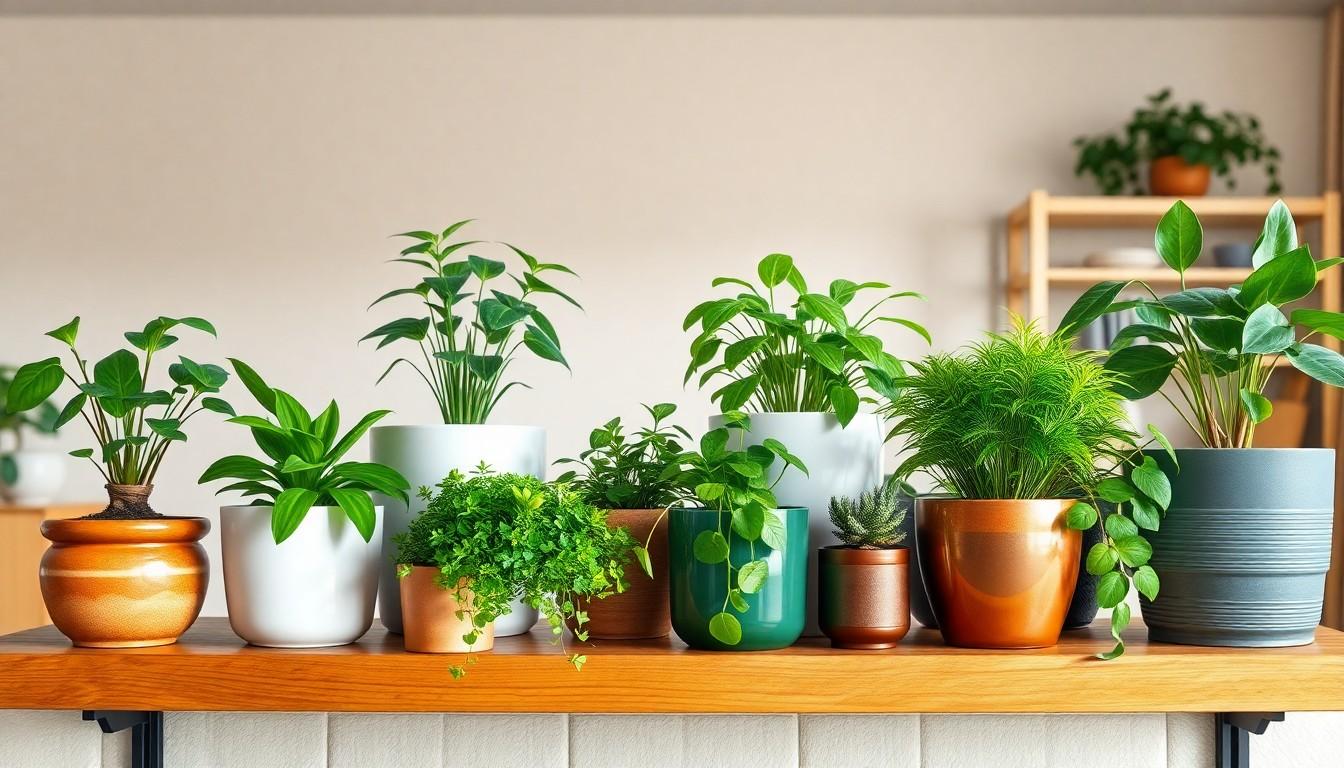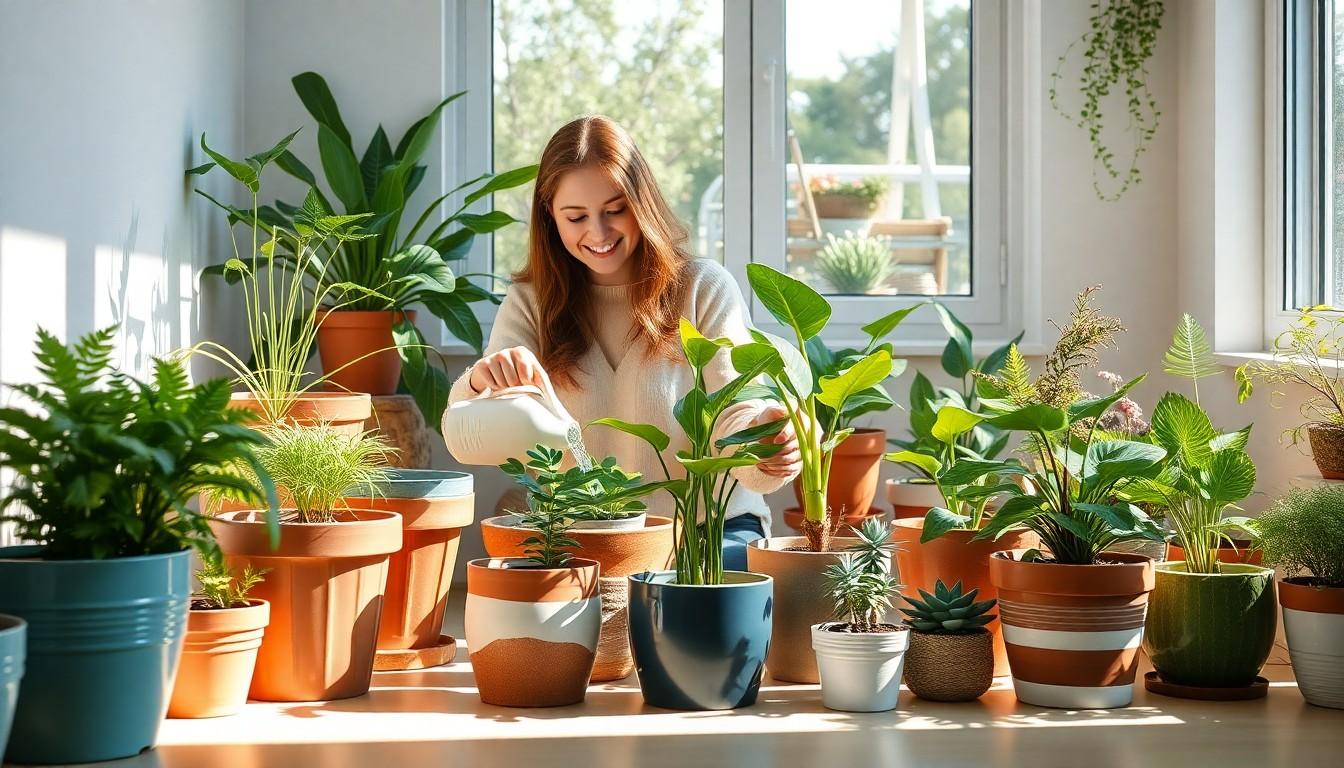Indoor plants are like little green superheroes, bringing life to dull spaces and purifying the air while they’re at it. But let’s not forget their trusty sidekick—the pot! Choosing the right pot isn’t just about aesthetics; it’s a crucial decision that can make or break your plant parenting journey.
Overview Of Indoor Plants Pots
Indoor plant pots come in various materials, shapes, and sizes, each serving unique purposes. Terracotta pots offer excellent breathability, allowing roots to access air. Plastic pots are lightweight and convenient, fostering easy movement. Ceramic pots provide a polished look, often featuring decorative designs.
Drainage plays a critical role in pot selection. Pots with drainage holes prevent overwatering by allowing excess moisture to escape. Alternatively, decorative pots might lack drainage, requiring gardeners to take extra care in watering routines.
Size also influences plant health. An appropriately sized pot supports root development, ensuring the plant has room to grow. Too large a pot can lead to overwatering, while a small pot might restrict growth.
Choosing the right pot color can enhance aesthetic appeal. Bright colors may energize spaces, while neutral tones often create a calming atmosphere.
Specific indoor plants benefit from specific pots. For instance, succulents thrive in shallow containers, while larger varieties like fiddle leaf figs require more depth. Research confirms that matching pot styles to plant species optimizes growth potential.
Some pots incorporate self-watering features, reducing maintenance efforts. These designs help maintain consistent moisture levels, ideal for busy individuals.
Terracotta, plastic, ceramic, and metal remain popular pot choices. Each material offers distinct advantages and drawbacks, impacting longevity and maintenance routines.
Ultimately, selecting an ideal indoor plant pot combines aesthetics and functionality. Understanding the relationship between the pot and plant health ensures thriving indoor gardens.
Types Of Indoor Plants Pots

Various types of indoor plant pots cater to different needs and preferences. Understanding each type helps in selecting the right pot for specific plants.
Ceramic Pots
Ceramic pots excel in aesthetic appeal and can enhance any indoor environment. Their ability to retain moisture makes them suitable for plants requiring consistent hydration. Decorative designs often adorn these pots, adding character to spaces. While heavier than plastic options, ceramics provide stability for taller plants. Drainage holes are commonly included, ensuring excess water escapes.
Plastic Pots
Plastic pots are lightweight and versatile, making them ideal for mobility. They come in various colors and styles, appealing to diverse tastes. The material is durable and resistant to breaking, which adds practicality. Many plastic options include built-in drainage systems, preventing overwatering issues. Additionally, their cost-effectiveness makes them popular among indoor gardeners.
Metal Pots
Metal pots create a modern and sleek look, fitting well in contemporary settings. They offer excellent durability and can withstand various environmental conditions. Responsiveness to temperature changes can be a double-edged sword; they heat up quickly in sunlight. A liner is often necessary to prevent rusting and retain moisture. These pots typically suit plants that thrive in controlled settings, benefiting from the unique aesthetic they provide.
Choosing The Right Indoor Plants Pot
Selecting the right pot for indoor plants significantly impacts their growth and overall health. Focus on aspects like size and drainage to ensure the ideal environment.
Size Considerations
Choosing the correct size pot supports healthy root development. A pot that’s accurately sized allows roots to spread without constraint, while a too-large pot can retain excess moisture, potentially leading to root rot. Conversely, a pot that’s too small stifles growth, preventing plants from accessing necessary nutrients and water. As an example, a 6-inch pot suits most small to medium houseplants, while larger varieties might need 10 inches or more. Consider the plant’s current size and its expected growth to select an appropriate pot size.
Drainage And Material
Drainage plays a crucial role in indoor plant care. Pots with drainage holes allow excess water to escape, preventing overwatering issues. Terracotta pots, known for their breathability, help regulate moisture levels. Ceramic pots can retain water, suitable for plants that thrive in consistent hydration, yet require cautious watering practices. Plastic pots often come equipped with drainage systems, making them a versatile choice. Selecting the right material alongside adequate drainage ensures plants receive the appropriate amount of water, promoting healthy growth.
Caring For Indoor Plants Pots
Caring for indoor plant pots involves both maintenance and proper techniques to ensure plant health. Routine cleaning and repotting contribute significantly to their longevity and the overall well-being of the plants.
Cleaning Pots
Regularly cleaning pots maintains their aesthetic and health benefits. Dust and debris can hinder drainage and promote mold growth. Utilize warm soapy water and a soft brush to remove buildup. Rinsing thoroughly prevents any soap residue that could affect roots. After cleaning, allow pots to dry completely before using them again. Avoid harsh chemicals that might damage the pot material or harm plants.
Repotting Tips
Repotting ensures plants have adequate space for root growth. Timing depends on plant type and pot size; typically, every 1 to 2 years is appropriate. Choose a pot 1 to 2 inches larger in diameter for expanding roots. When repotting, gently loosen the root ball and remove dead or damaged roots. Fill the new pot with fresh soil, placing the plant at the same depth as in the previous pot. Water thoroughly after repotting to help the plant settle and reduce transplant shock.
Benefits Of Using Indoor Plants Pots
Using indoor plant pots enhances the living space in various ways. Improved air quality stems from plants filtering harmful pollutants and providing oxygen. Aesthetic appeal adds to the environment, as colorful pots complement interior design styles.
Pot selection influences plant health significantly. Proper-sized pots promote root development, allowing plants to access nutrients effectively. When roots have room to spread, growth flourishes. For example, a 6-inch pot suits many small to medium houseplants.
Drainage plays a crucial role in plant care. Pots with drainage holes prevent water accumulation, reducing the risk of root rot. Excess moisture creates an unhealthy environment, but decorative pots with careful watering routines can still serve well.
Material choice affects durability and maintenance. Terracotta pots offer breathability, enhancing soil aeration. Lightweight plastic pots provide versatility and ease of handling, while ceramic pots retain moisture, making them ideal for plants with consistent hydration needs.
In addition, regular maintenance ensures pots contribute to plant health. Cleaning removes dust and debris, promoting proper drainage and preventing mold growth. Using warm soapy water and a soft brush, followed by rinsing, keeps pots in optimal condition.
Repotting also serves as an essential practice for healthy plants. Every 1 to 2 years, pots should be replaced with a size increase of 1 to 2 inches in diameter. By carefully loosening root balls and using fresh soil, plants continue to thrive in a healthy environment.
Conclusion
Choosing the right indoor plant pot is essential for both plant health and aesthetic appeal. By understanding the unique needs of each plant and the characteristics of various pot materials, individuals can create thriving indoor environments.
Proper drainage and pot size play crucial roles in supporting healthy root development and preventing issues like overwatering. Regular maintenance practices such as cleaning and repotting ensure that plants receive the care they need to flourish.
Ultimately, thoughtful pot selection not only enhances the beauty of living spaces but also contributes to a healthier indoor atmosphere. With the right pots in place, indoor gardening can be a rewarding experience that brings joy and vitality to any home.

